
In the Rocky Mountain region of New Mexico, Colorado, Utah, and Wyoming, an integrated network of more than 12.5 billion cubic feet (Bcf) per day of natural gas pipeline infrastructure is in place for collection, aggregation and processing. The systems serve regional consumers and send excess supply to the Pacific Northwest, West, Southwest, Midcontinent and eastern U.S. markets.
Recent additions to this impressive capability include the Ruby Pipeline (westbound, 1.5 Bcf per day), the Bison Pipeline (eastbound, 0.4 Bcf per day), and Kern River Transmission’s most-recent expansion projects (southbound, 0.41Bcf per day).
Overall, natural gas transmission systems within the Rockies are now significantly better integrated than in the past, allowing gas to flow northwest, west to east, east to west, south to north, and south within and from the region. Many historical internal and regional exit-capacity constraints have been reduced or eliminated. Although development in some areas has slowed somewhat, future gas production will benefit from this generally available and flexible access to pipeline capacity and markets.
Meanwhile, gas trading hubs in Cheyenne and Opal, Wyoming, and in Meeker-Greasewood, Colorado, are serving Rocky Mountain gas producers. The hubs’ related activities are expected to greatly enhance the overall market balance and flexibility after decades of constraint and uncertainty. With fewer intraregional capacity constraints, sufficient take-away capacity and lower price volatility, local natural gas prices are stable and predictable, thus providing a clearer environment for development planning and investment decisions. As a result, as in other U.S. supply areas, exploration and production companies are seeking natural gas liquids (NGL) opportunities within their Rockies portfolios.
Oil-development activities have also increased in the Rockies. For example, in 2010, Utah’s annual production, at 24.6 million barrels (bbl.) per year, was at its highest level since 1991, while natural gas production has remained relatively stable for the past several years. A record-setting 3,677 oil wells and 6,328 gas wells are now producing in Utah.
An analysis of key Rockies’ regional producing areas and the details of specific oil and gas midstream infrastructure, via a circular route beginning in western Wyoming and traversing eastward across the state while picking up development along the Front Range in eastern Colorado and extending into southern Colorado, New Mexico and Central Utah, show that the region will require more NGL infrastructure.
Overthrust area, Wyoming Thrust Belt
One of the older supply developments in the Rockies region is the Overthrust area, which consists of supply developments in southwestern Wyoming and northeastern Utah. Historically, gas developments were predominant and most were hydrocarbon-rich, but there were oil and condensate developments as well.
Years ago, the Painter and Ryckman Creek oil reservoirs entered secondary and tertiary recovery mode to facilitate overall recoveries. The Ryckman Creek reservoir is in the process of being converted to future natural gas storage service, with initial service beginning as early as mid-2013. Gas in this area is generally routed to the Questar Pipeline, into the Overthrust Pipeline, or to Kern River Pipeline. Current new supply development activity in this area is minimal.
Greater Green River, Jonah-Pinedale, vicinity of Opal, Wyoming (West)
Moving eastward in Wyoming, the western portion of the Greater Green River Basin provides significant resource potential. Several major gas-gathering systems terminate into numerous gas-processing plants. The systems include the Jonah Gas gathering system (capacity of 2 Bcf per day), the gathering systems upstream of Williams Cos.’ Opal processing plant, and the Rendezvous Pipeline and gathering system.
Williams’ Opal plant has a processing capacity of 1.45 Bcf per day, and Enterprise Products Partners LP’s Pioneer plant can process up to 0.75 Bcf per day. The Western Gas Partners’ Granger gathering and processing system is capable of managing 0.35 Bcf per day. That complex also contains a limited NGL fractionation capability of 9,500 bbl. per day. The Opal Hub in Wyoming is a key infrastructure point and supports a major regional market-trading hub, as numerous pipelines have connected to one another and to the various gas-processing plants in the Opal area.
The Kern River Gas Transmission system (2.2 Bcf per day) originates in the Opal area. The recently implemented 1.5 Bcf per day Ruby Pipeline is also configured to receive the majority of its volumes in this area. These major pipelines will aggressively compete for volumes in the Opal area. Kern River markets are in Nevada and southern California while Ruby Pipeline’s markets are primarily in northern California and northern Nevada..
To date, an extensive NGL pipeline infrastructure has been developed to support NGLs removed from the various area supply sources. Mid-American Pipeline Co.’s (MAPL) Rocky Mountain NGL Pipeline is a FERC-regulated pipeline that collects NGLs from the Opal plant, from the Pioneer plant and other area plants. Its capacity is 275,000 bbl. per day. A proposed expansion would increase that number by 85,000 bbl. per day by third-quarter 2014. Regional NGLs are routed to downstream fractionators at Hobbs, New Mexico, or further downstream via the Seminole NGL Pipeline to Mont Belvieu, Texas.
The Overland Pass NGL Pipeline system also originates at the Opal plant, routes eastward and connects to its Piceance Basin gathering lateral (capacity 100,000 bbl. per day), and connects to the Echo Springs processing-plant complex.
Overall NGL gathering capacity from the Opal area to the Echo Springs plant is 110,000 bbl. per day with 150,000 bbl. per day of capacity from the Echo Springs plant downstream. An additional NGL gathering lateral to the Denver-Julesberg (D-J) Basin provides the ability to collect up to 55,000 bbl. per day of NGLs, while a proposed gathering lateral to the Bakken supply region in North Dakota would add up to 60,000 bbl. per day by mid-2013. This latter expansion would trigger a further downstream capacity expansion of 75,000 bbl. per day on the Overland Pass system, yielding a maximum capacity of 255,000 bbl. per day. OneOk’s existing Bushton, Kansas, fractionator would also be expanded by 60,000 bbl. per day to manage a portion of the overall system’s incremental NGL volumes.
Recent Rockies internal-delivery gas pipeline expansions significantly altered connectivity and reconfigurations and expansions of Overthrust Pipeline, Wyoming Interstate, Colorado Interstate, Questar Pipeline and others have resulted in an additional 1.5 Bcf per day of marketable supplies imported daily into the greater Opal trading area. These volumes will seek to compete for market share and available pipeline take-away capacity—eastbound, westbound and southbound.
Some of these volumes have initially provided sourcing capability to the Rockies Express Pipeline. Now, they can also flow westward within the region and, most-recently, are providing a sourcing capability into the new Ruby Pipeline. For specific area infrastructure data, see Table 1.
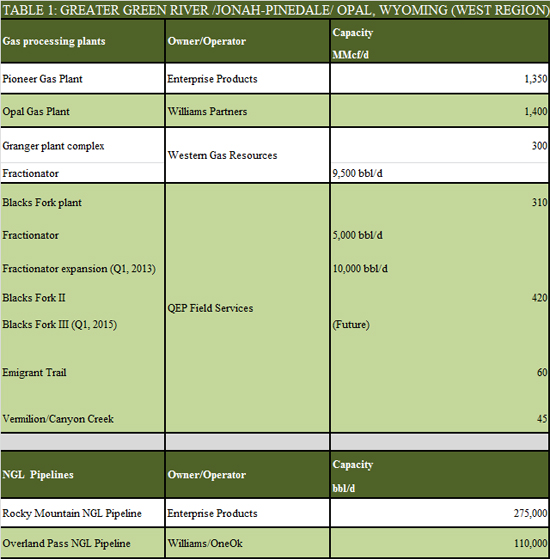
Greater Green River/Wamsutter, Wyoming (East)
The eastern portion of the Green River Basin also has significant resource potential. Gas from this region has historically flowed east toward the Cheyenne Hub and traditional local Rockies markets, while some volumes are routed into the Rockies Express Pipeline to seek eastern U.S. markets.
Wamsutter, Wyoming, has become a bi-directional interconnection point for several of the new or reconfigured regional pipeline systems, where gas volumes are aggregated from the east and west portions of the Greater Green River area as well as volumes received from the Uinta Basin and Colorado’s Piceance Basin. This flexibility and bi-directional flow capability is transformative to the Rockies region and is a welcome addition for upstream producers and other market participants.
Gas processing plants and related NGL pipeline infrastructure have also been implemented in this area to support NGLs from the various supply sources. Williams Partners LP’s’ Wamsutter gasgathering system consists of over 1,700 miles of facilities. Although it is smaller than its western neighbors, its Echo Springs gas plant has the capacity to process 0.74 Bcf per day and create or manage up to 60,000 bbl. per day of NGLs. Liquids from this plant also connect to the Overland Pass NGL Pipeline and are fractionated downstream.
Collectively, the Greater Green River areas are primarily gas-prone with limited oil production. Gas is generally hydrocarbon-rich and is processed. Total produced oil volumes for 2010 were about 15 million bbl. annually, while gas volumes were at 1.4 trillion cubic feet annually. Compared to 2010, volumes of gas appear to be down by about 12% to date in 2011, indicative of a scaling back pending the expected arrival of capacity on the Ruby Pipeline or on overall gas economics. For specific area infrastructure data, see Table 2.
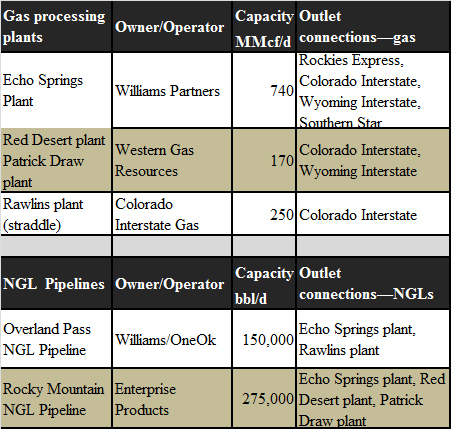
Wind River, Big Horn, Powder River
The Big Horn and Wind River basins are sourced primarily from historical conventional resources. The Big Horn area is a combination of an oil play (12 million bbl. annually) and a gas play (about15 Bcf annually). The Wind River area consists of a combination of oil (about 4.5 million bbl. annually) and gas (about 175 Bcf annually) development areas.
Portions of the area gas are associated with oil production, so gas in the region must be processed to achieve marketable gas quality.
The Powder River Basin is sourced primarily from coal-bed methane wells. The Powder River wells are very shallow and low pressure. The daily production volume for each well is rather small, so sustaining or growing area supply requires significant ongoing drilling and development activity.
However, after an initial production surge, these wells produce for many years. Much of the coal-bed methane produced requires treating for CO2 and requires management of significant amounts of water produced along with the gas stream. Typically, the gas has a low BTU content and must be managed appropriately.
In the years from 2008 through 2010, Powder River production remained relatively flat at about 0.5 trillion cubic feet annually, but is trending downward.
Specifically, during the first nine months of 2011, production was recorded at 0.356 trillion cubic feet, or down an estimated 11% from similar-period 2010 annual levels. Water management issues, service costs and low natural gas prices have negatively affected ongoing drilling and development.
Gas from these basins can be sent directly into Front Range markets, traded at the Cheyenne Hub or transported to other markets. Expansions of the Williston Basin Pipeline and the recently-implemented Bison Pipeline (0.4 Bcf per day) have provided new delivery capability into the Northern Border Pipeline, thus providing access to Midwest markets and pricing.
Niobara shale activity, southeastern Utah, Lower Powder River Basin
Although not quite as active as in other areas, operators have positioned themselves to develop the Niobrara shale in this area. To date, gas infrastructure requirements have been met either by connections to existing facilities or by flaring. When required, oil and NGLs are moved by trucking or by other non-pipeline modes of transportation.
Niobrara shale activity, Northeast Colorado, Denver-Julesberg Basin
One of the region’s hottest areas is the Niobrara shale development, which has joined other ongoing unconventional oil and gas development activity in the D-J Basin. Because the basin is in northeast Colorado proximate to the Denver area and regional consuming markets, gas can access local markets or can choose to compete with other gas for regional take-away capacity at the Cheyenne, Wyoming, hub.
In a few recent instances, gas volumes associated with ongoing oil or condensate development have been flared until volumes are of sufficient scale to justify investment in the implementation of gas-gathering facilities.
Recent activity in the D-J Basin has focused in the development of liquids-rich gas and oil resources. Recently, Anadarko Petroleum Corp. announced that its recent Wattenberg field development activities are yielding strong initial rates of production and high levels of liquids.
Anadarko purchased BP Plc’s interest in Wattenberg gas plant with capacity to process 0.195 Bcf per day of gas and create or manage 15,000 bbl. per day of NGL’s and condensate. Western Gas Partners’ Wattenberg area gathering system consists of more than 1,700 miles of gathering and the Platte Valley gas processing plant (0.105 Bcf per day). DCP Midstream and DCP Midstream Partners’ area systems consist of seven gas processing plants with total capacity of over 0.300 Bcf per day. An eighth area gas processing plant with 0.110 Bcf per day is scheduled for service by mid-2013. DCP Midstream is also preparing a pipeline, recently purchased from Buckeye Pipeline Partners, for incremental NGL service from its various plants to the Conway, Kansas, NGL hub.
On the crude oil side, the White Cliffs Pipeline, with its recent expansion, is currently providing 50,000 bbl. per day of delivery capacity from the area to the Cushing, Oklahoma, oil-trading hub. A recent announcement by the facility operator, SemCrude LP, indicates that its truck unloading facilities at Platteville will be expanded to manage additional receipts from Anadarko Petroleum into the pipeline. Current facilities provide for 29,700 bbl. per day of off-loading capability. Expansion is expected to be complete by year-end 2012 and will provide for a total capability of 49,500 bbl. per day.
For specific area infrastructure data, see Table 3.
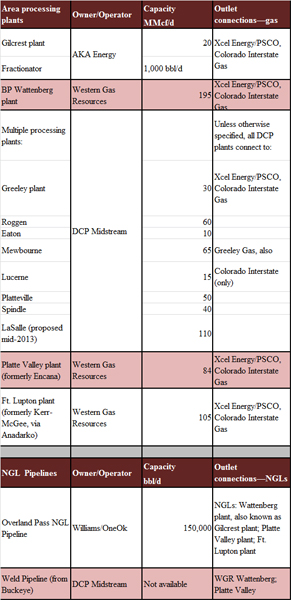
Raton Basin, Southeastern Colorado
The Raton Basin sits in far southeastern Colorado and northern New Mexico and contains coal-bed methane resources. It is connected only to the Colorado Interstate Gas (CIG) pipeline system. These volumes have avoided some of the historical Rockies regional export capacity constraints and many of the negative pricing issues of other Rockies regions. However, at times the production was high enough to cause capacity constraints on the CIG Pipeline system.
Volumes produced in the region have generally flowed via CIG into markets in Kansas, Oklahoma and Texas. CIG has recently provided a limited northbound backhaul capability of 0.135 Bcf per day by implementing a 16-inch pipeline northward from the Raton area to connect to portions of the CIG system more proximate to the Front Range and the Cheyenne Hub. There, Raton volumes can access a broader pipeline array for markets.
According to one operator, the natural gas infrastructure in the area is adequate to support current production levels. That operator, Pioneer Natural Resources Co., which is the largest operator in the Raton basin, suspended its Raton midstream development to focus on other liquids-rich areas.
Piceance Basin, Colorado
The Piceance Basin in Colorado, often considered to be geologically combined with the Uinta basin, is one of the three largest resource areas in the Rockies. To date, much of the development in the Piceance Basin has been focused on tight-sands development. The terrain is difficult and the geology is complex.
Despite the complexity, producing operators in the region have been very successful, but development has slowed due to continued low gas prices. Much of the gas in this area routes to the Meeker-Greasewood area where it is processed or treated at Enterprise Product Partners’s Meeker gas processing and treatment plant. From there, it can interconnect to the Rockies Express Pipeline to move to markets in the eastern U.S.
At Meeker, the White River trading hub also provides additional routing flexibility. One option allows gas to be directed toward Questar’s Clay Basin storage or into Kern River Pipeline to reach western markets. Activity in the area has been bolstered by the uplift by natural gas liquids. However, some gas contains high CO2 levels and thus treatment is required prior to pipeline delivery. For specific area infrastructure data, see table 4.
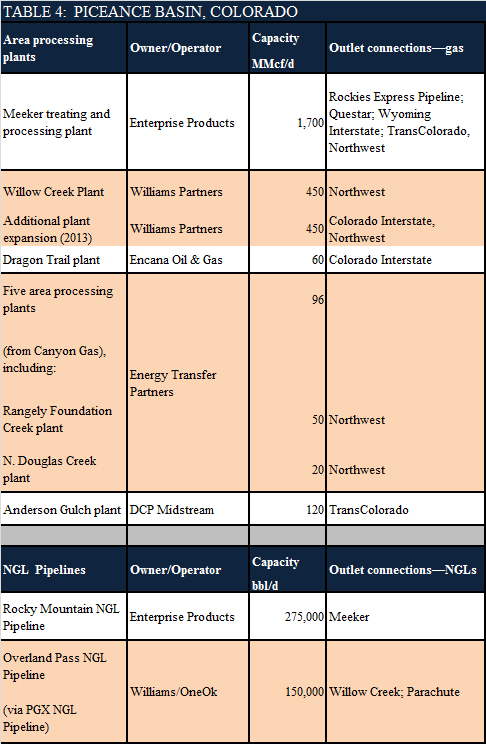
Uinta Basin, Utah
The Uinta basin produces oil and gas, with much of the oil development focused in Duchesne County. Gas development is found primarily in Uintah County.
Western Gas Partners LP’s Natural Buttes gas-gathering system is one of the area’s largest, connecting to the Chipeta gas processing plant (500 million cubic feet per day capacity). NGL pipelines from Chipeta can route up to 30,000 bbl. per day to the Rocky Mountain NGL Pipeline (MAPL).
Historically, gas volumes developed in this area have been severely impacted by local infrastructure and pipeline-capacity constraints. However, in the past several years projects and expansions now provide capability and flexibility to access multiple markets. For example, producers can move gas north from the area and can access pipelines to route volumes west to the Opal hub or east to the Cheyenne hub. Gas can flow westward on Questar Pipeline Co.’s system to access markets at Clay Basin storage or can be routed via Questar’s Southern System into Kern River Pipeline. Also, with access to the White River trading hub at Meeker/Greasewood, gas can find markets there or access additional pipeline capacity to other markets.
This flow flexibility to multiple markets may be enhanced further as Questar Pipeline managers consider additional expansion of the southern system to provide additional capabilities into the Kern River and Opal area or as Williams Cos.’ Northwest Pipeline continues to evaluate its options in the area. For specific area infrastructure data, see table 5.
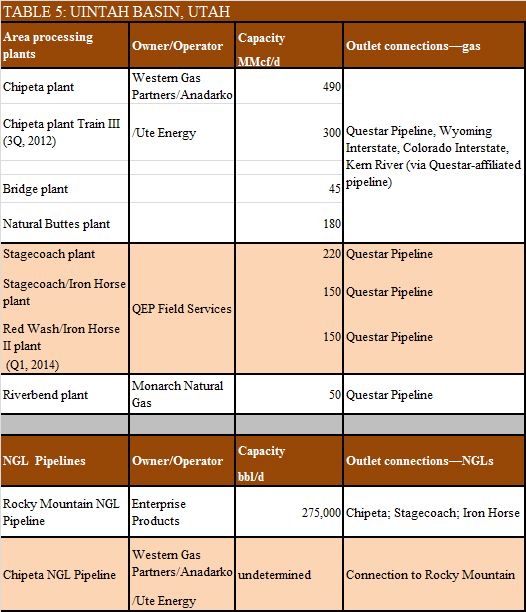
San Juan Basin, New Mexico
For many years, the San Juan Basin in New Mexico experienced development of coal-bed methane gas resources that were assisted significantly by federal tax credits. Since 1988, the development of the Fruitland coal seam has proved to be the major supply. Yet, since those tax credits expired and with overall low gas prices, area development has slowed.
Paradox Basin, Utah
The Paradox Basin is in southeastern and south-central Utah and extends into southern Colorado. Historically, oil development has been the principal focus and remains such. The greater Aneth field, after many years of secondary CO2 injection techniques, remains an active producer, having produced more than 460 million bbl. since its inception in 1956.
Recently, oil production in Utah has been returning to peak historical levels, with some 24 million bbl. produced in 2010 from 3,365 wells. This compares to similar production levels in 1992 of 24 million bbl. from 1,820 wells.
This comparison indicates that area developers have had to significantly increase the number of wells to restore previous production levels. With increasing activity and strong oil prices, oil volumes are expected to continue to increase. Natural gas activity levels in this basin are modest because this area appears to have one of the smaller gas resources in the Rockies. For any associated gas, Questar Pipeline provides the principal take-away.
Summary
In summary, the Rockies region consists of a significant number and variety of midstream assets. As the region is quite large and diverse, and commodities consist of oil, liquids-rich gas and conventional gas, numerous key market players are active. Some area activities have plateaued or reached sustaining mode. Others are increasingly active and their midstream infrastructure requirements will continue to grow.
Overall infrastructure has developed over time to support individual needs, but today it is much more integrated. As a result of that integration, regional capacity constraints have disappeared. The ability to trade gas in the area and route gas selectively to multiple markets is now supported.
Although individual play developments, especially the rich-gas areas, might require additional midstream gathering, processing or treating capacities, the macro infrastructure in the Rockies region now provides effective support and market access.
Recommended Reading
Small Steps: The Continuous Journey of Drilling Automation
2024-12-26 - Incremental improvements in drilling technology lead to significant advancements.
Understanding the Impact of AI and Machine Learning on Operations
2024-12-24 - Advanced digital technologies are irrevocably changing the oil and gas industry.
Exclusive: Novi Labs’ Ludwig on AI Preventing Costly Drilling Mistakes
2024-12-12 - Novi Labs President and Co-Founder Jon Ludwig gives insight on how AI and machine learning allow diverse applications for oil and gas operations and less risk for cataclysmic failure, in this Hart Energy Exclusive interview.
Permanent Magnets Emerge as a Game-Changer for ESP Technology
2024-12-19 - In 2024, permanent magnet motors installations have ballooned to 11% of electric submersible pump installations, and that number is growing.
Pioneer Energy’s Tech Offers More Pad Throughput, Fewer Emissions
2025-01-14 - Pioneer Energy’s Emission Control Treater technology reduces emissions and can boost a well’s crude yield by 5% to10%, executives say.
Comments
Add new comment
This conversation is moderated according to Hart Energy community rules. Please read the rules before joining the discussion. If you’re experiencing any technical problems, please contact our customer care team.





